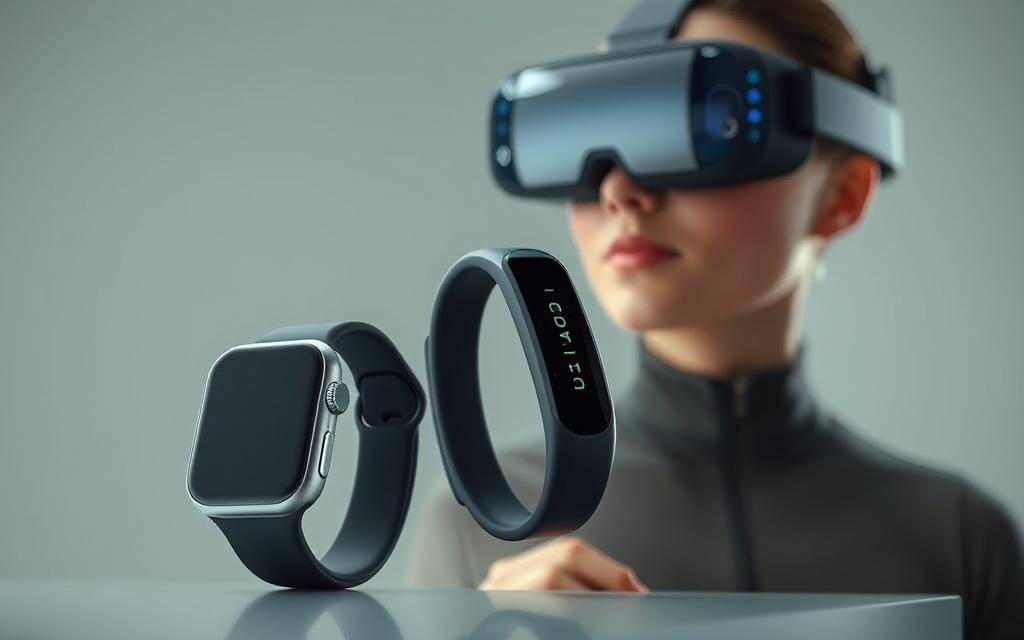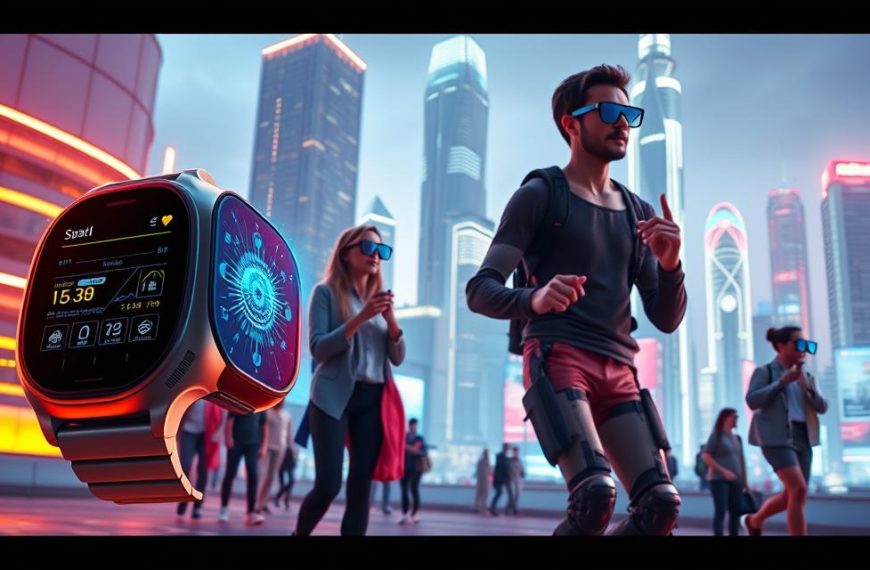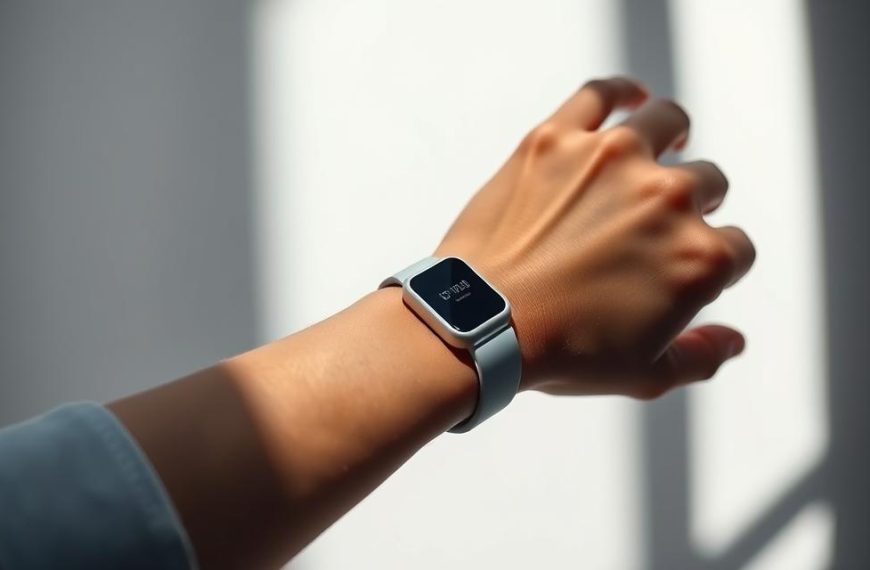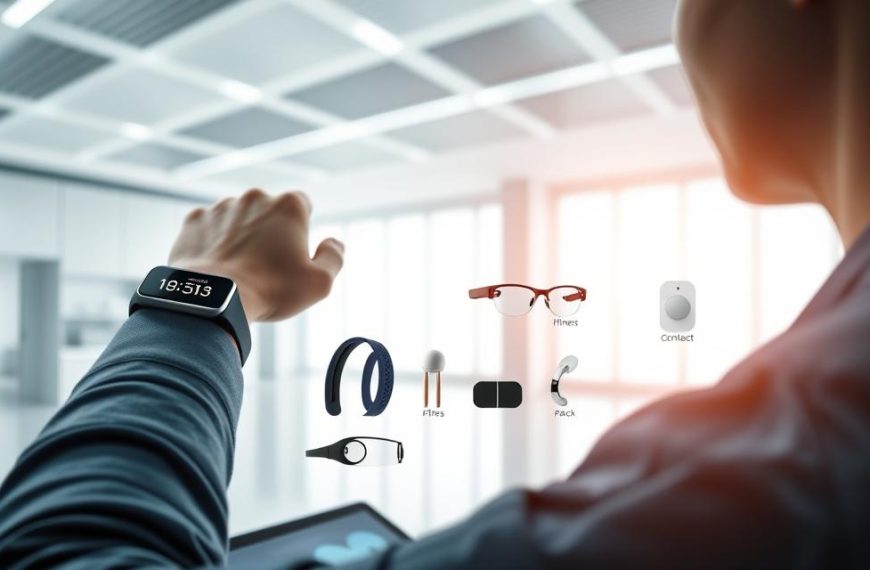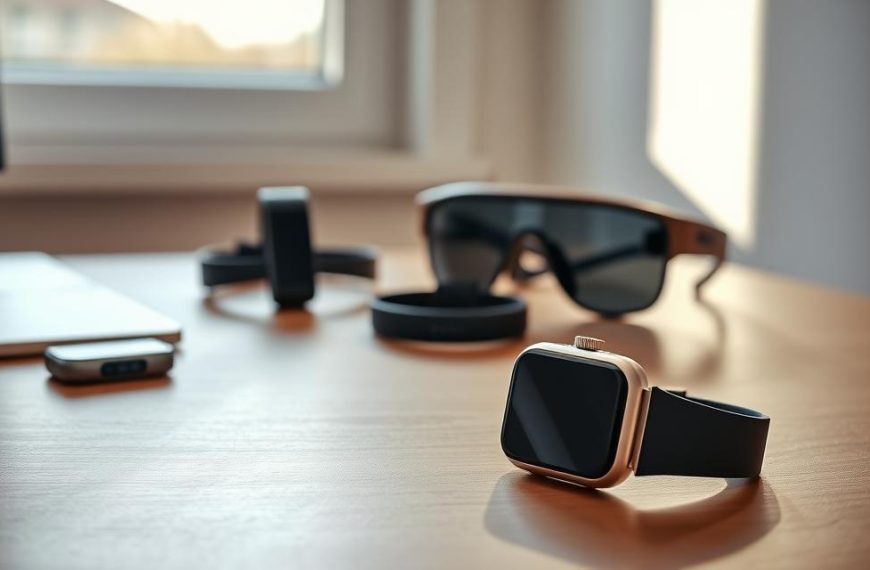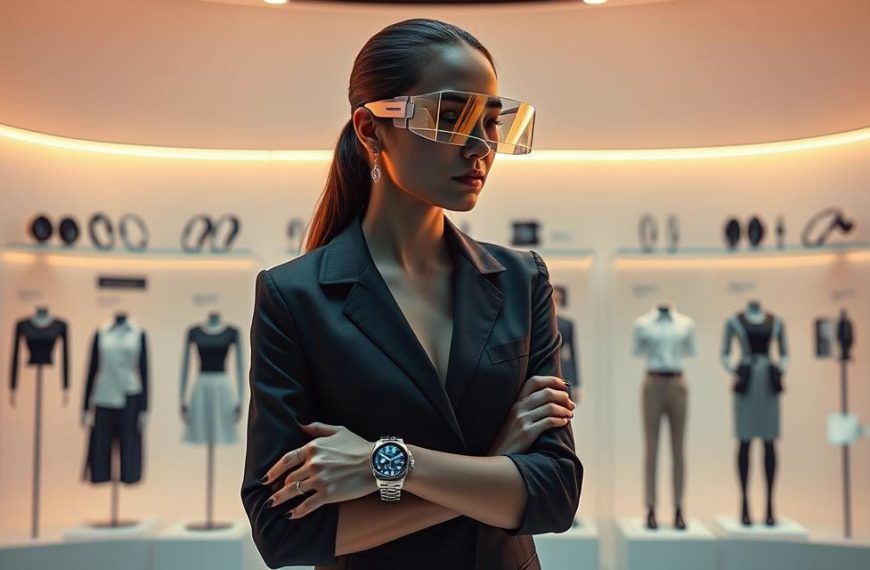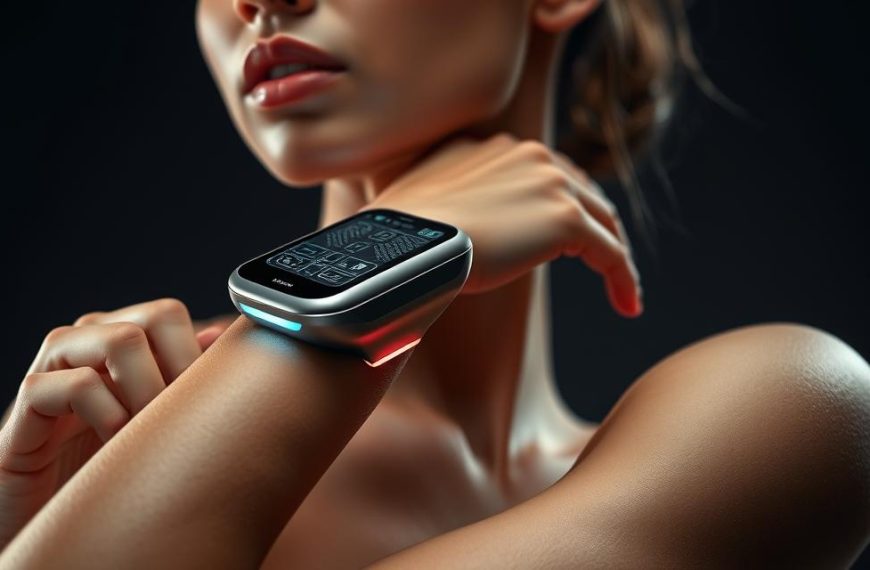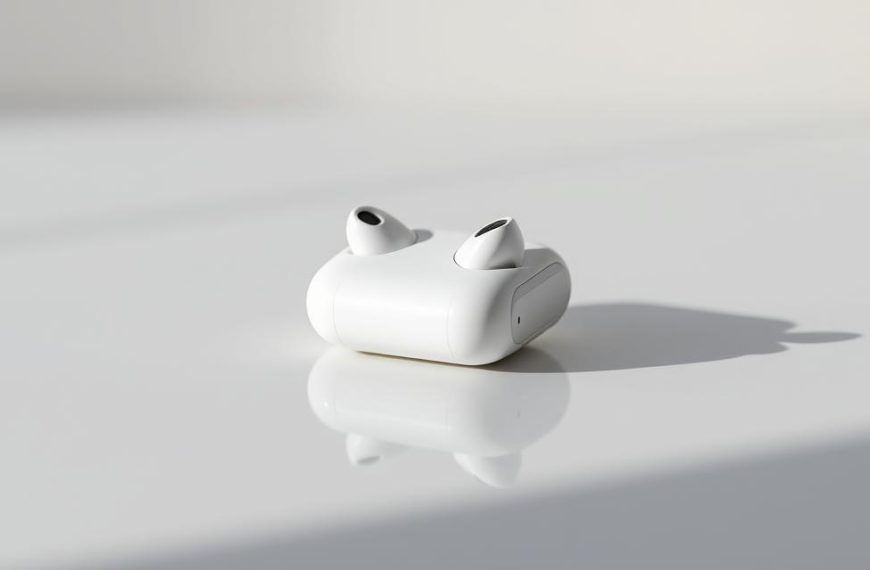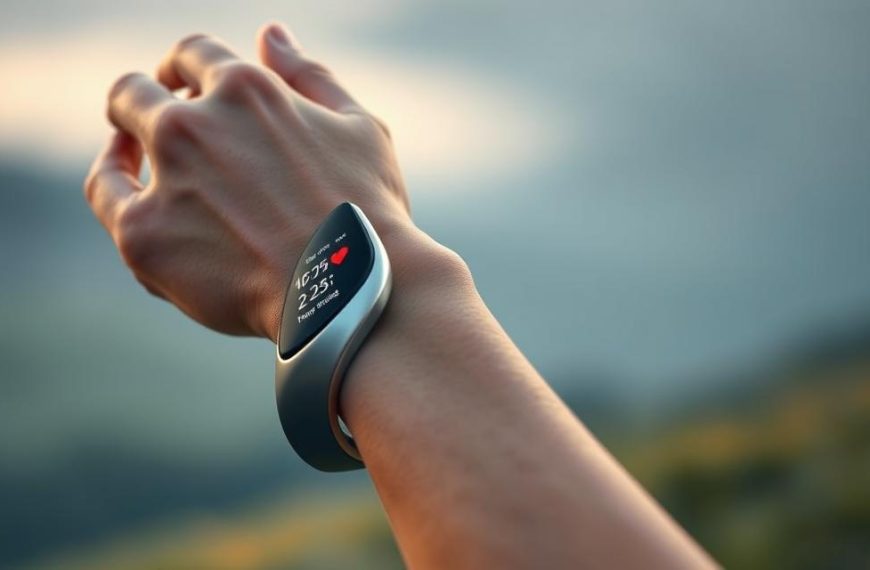Wearable technology has transformed the way we interact with devices. These body-worn electronics blend fashion with advanced computing, making them both functional and stylish. From fitness trackers to VR headsets, these tools are designed to enhance daily life.
Popular examples include the Meta Quest VR headset and the Fitbit Charge fitness tracker. These devices use embedded sensors and microprocessors to process data in real time. This allows users to monitor health, navigate virtual worlds, and more.
Modern innovations like AI-powered hearing aids and Microsoft HoloLens holographic computers push the boundaries of what’s possible. This article explores the components, applications, and ethical implications of this evolving tech.
Introduction to Wearable Technology
From humble beginnings to cutting-edge innovations, wearable tech has come a long way. Its roots trace back to the 13th century with the invention of eyeglasses, one of the earliest examples of body-worn devices. Today, it spans from medical skin patches to advanced VR headsets, showcasing a wide range of sophistication.
Modern devices vary from simple disposable medical sensors to complex systems like AI-powered e-skin patches developed by the Terasaki Institute. These innovations highlight the blend of simplicity and advanced computing in wearable tech.
The adoption of these devices has surged due to increased health awareness during COVID-19 and advancements in the Internet of Things (IoT). Users now rely on wearables for fitness tracking, virtual experiences, and more.
Major categories include smartwatches like the Apple Watch, AR/VR gear such as the Meta Quest, and smart clothing. Sony’s Walkman, a pioneering wearable audio device, laid the foundation for today’s portable tech.
| Category | Examples | Functionality |
|---|---|---|
| Smartwatches | Apple Watch | Fitness tracking, notifications |
| AR/VR Gear | Meta Quest | Immersive virtual experiences |
| Smart Clothing | AI-powered fabrics | Health monitoring, comfort |
How Wearable Technology Works
The mechanics behind body-worn devices are both fascinating and complex. These tools rely on a combination of hardware and software to deliver real-time insights. From fitness trackers to VR headsets, the seamless integration of components ensures smooth functionality.
Components of Wearable Devices
Modern devices are built with advanced sensors, microprocessors, and connectivity modules. Sensors collect data like heart rate, motion, and temperature. Microprocessors analyze this information, while Bluetooth or Wi-Fi modules transmit it to apps or the cloud.
“The integration of sensors and processors has revolutionized the way we monitor health and interact with technology.”
Data Collection and Processing
The process begins with skin contact, where sensors gather biometric data. This information is transmitted via Bluetooth to apps for analysis. Machine learning algorithms, like those in Cardiogram’s watchOS app, predict health trends and detect anomalies.
Security is a top priority. Biometric data is encrypted during storage and transmission. Devices like the Oura ring use advanced protocols to ensure users’ privacy. However, challenges like latency in VR headsets remain, affecting motion processing accuracy.
| Component | Function |
|---|---|
| Sensors | Collect biometric data |
| Microprocessors | Analyze and process data |
| Connectivity Modules | Transmit data to apps or cloud |
Types of Wearable Devices
The variety of body-worn electronics available today caters to different needs and preferences. From health monitoring to immersive simulations, these devices have become essential tools in modern life. Two prominent categories include smartwatches, fitness trackers, and augmented or virtual reality headsets.
Smartwatches and Fitness Trackers
Smartwatches and fitness trackers are among the most popular body-worn devices. They help users monitor their health, track physical activity, and stay connected. Devices like the Apple Watch and Fitbit Charge use advanced sensors to measure heart rate, steps, and sleep patterns.
These tools are designed for convenience and accuracy. They sync with mobile apps to provide detailed insights into daily habits. Whether you’re a fitness enthusiast or just starting, these devices offer valuable support for achieving health goals.
Augmented and Virtual Reality Headsets
Augmented and virtual reality headsets create immersive experiences that transport users to new worlds. The Meta Quest Pro, for example, uses inside-out tracking for room-scale virtual reality without external sensors. This feature enhances the user’s freedom of movement.
There are two main types of systems: tethered and standalone. Tethered systems like the PlayStation VR2 require a connection to a console or PC. Standalone systems, such as the Oculus Quest 3, operate independently, offering greater portability.
Passthrough augmented reality, seen in devices like the Microsoft HoloLens 2, overlays digital information onto the real world. This technology is particularly useful in enterprise applications, such as training and design.
Display technologies also play a crucial role. OLED screens provide vibrant colors, while LCDs offer cost-effective solutions. A wider field of view and higher refresh rates, like 120Hz, help reduce motion sickness and improve the overall experience.
In fields like military training, virtual reality haptic suits simulate real-world scenarios. These advancements highlight the potential of headsets to transform industries and redefine how we interact with the digital world.
Applications of Wearable Technology
From fitness tracking to immersive gaming, body-worn devices are reshaping everyday experiences. These tools are no longer limited to health monitoring; they now span industries like entertainment, gaming, and even fashion. Their versatility makes them indispensable in modern life.
Healthcare and Fitness
Body-worn devices have revolutionized healthcare and fitness. They track vital signs, monitor physical activity, and provide real-time feedback. For example, fitness trackers like the Fitbit Charge help users achieve their health goals by analyzing steps, heart rate, and sleep patterns.
Advanced devices, such as AI-powered hearing aids, offer personalized solutions for medical conditions. These innovations empower users to take control of their well-being. The integration of sensors and apps ensures accuracy and convenience.
Entertainment and Gaming
The entertainment industry has embraced these devices to create immersive experiences. The Sony PlayStation VR2, for instance, offers 4K HDR visuals and head haptic feedback, enhancing the gaming experience. Free-roam VR arcade systems like Zero Latency take this a step further, allowing players to move freely in virtual worlds.
Haptic gloves, powered by Meta’s ReSkin technology, add a tactile dimension to gaming. AR concert experiences, such as Wave’s virtual Justin Bieber performances, blend reality with digital artistry. These advancements redefine how we engage with entertainment.
Smart jewelry, like the Gucci x Will.i.am collaboration, merges fashion with functionality. Spatial audio in devices like Bose Frames sunglasses enhances the experience of music and phone calls. These innovations highlight the limitless potential of body-worn devices in gaming and beyond.
Benefits of Wearable Technology
Body-worn devices are revolutionizing industries by enhancing efficiency and improving daily routines. These tools offer a wide range of advantages, from health monitoring to boosting workplace productivity. Let’s explore how they are making a difference.
Health and Fitness Monitoring
One of the most significant benefits is their ability to track health and fitness. Devices like the Fitbit Charge monitor heart rate, steps, and sleep patterns. This data helps users make informed decisions about their well-being.
Advanced tools, such as AI-powered hearing aids, provide personalized solutions for medical conditions. These innovations empower users to take control of their health in a proactive way.
Enhanced Workplace Productivity
In the workplace, these devices are transforming operations. For example, Amazon warehouses use wrist-worn scanners, reducing item retrieval time by 40%. This efficiency boosts overall productivity.
Smart glasses like the Vuzix M400 are used in field service applications, providing hands-free access to critical information. Similarly, Guardhat IoT helmets enhance safety on construction sites by monitoring environmental conditions.
Translation wearables, such as the Timekettle M3, bridge language barriers for multinational teams. UPS leverages driver biometrics through its ORION system to optimize routes. Boeing’s factory AR implementations have also shown significant productivity gains.
Challenges and Criticisms of Wearable Technology
While body-worn devices offer numerous benefits, they also face significant challenges. From privacy concerns to high costs, these issues can impact the consumer experience and limit accessibility. Let’s explore the key criticisms and how they shape the tech landscape.
Privacy and Data Security
One of the most pressing issues is the handling of personal data. Many devices collect sensitive information, such as health metrics and location data. If not properly secured, this data can be vulnerable to breaches.
For example, fitness trackers often sync with apps that store user information in the cloud. While encryption helps, there’s always a risk of unauthorized access. Consumers must be vigilant about the permissions they grant and the security measures in place.
“Data privacy is not just a feature; it’s a fundamental right that must be protected in every device.”
High Costs and Accessibility
Another major barrier is the costs associated with these devices. High-end models like the Apple Watch Ultra or Garmin Epix Pro can be prohibitively expensive for many consumers. Even mid-range options often require additional subscriptions for full functionality.
Insurance coverage for medical wearables remains inconsistent. While some states offer Medicaid reimbursement, others leave patients to bear the full costs. Initiatives like Repairo aim to bridge this gap by providing refurbished diabetes tech at lower prices.
The FDA’s approval of over-the-counter hearing aids has also made a significant impact. Prices for devices like AirPods Pro dropped from over $4,000 to $249, making them more accessible to a wider audience.
| Device | Price | Subscription Model |
|---|---|---|
| Apple Watch Ultra | $799 | Optional |
| Garmin Epix Pro | $899 | Optional |
| Whoop | $30/month | Required |
| Oura Ring | $299 + $5.99/month | Required |
Despite these challenges, wearables can improve access to healthcare for users with limited financial resources. For more insights, explore how these devices are transforming healthcare here.
The History of Wearable Technology
The journey of body-worn electronics has been marked by groundbreaking innovations and rapid evolution. From simple tools to advanced systems, these devices have transformed how we interact with the world. Let’s explore the milestones that shaped this fascinating field.
Early Innovations
The roots of wearable tech trace back to the 1980s, with the introduction of the Sony Walkman. This portable music player revolutionized personal audio, setting the stage for future advancements. In the 2000s, the first fitness trackers emerged, offering basic step-counting features.
One of the most significant early breakthroughs was the development of MEMS (Micro-Electro-Mechanical Systems) sensors. These tiny components enabled precise motion tracking, paving the way for modern devices like the Apple Watch. Graphene adoption in flexible displays further enhanced durability and performance.
Modern Advancements
Today, wearable technology has reached unprecedented heights. The Apple Watch, for instance, evolved from a notification tool to a certified medical device. It now monitors heart health, detects falls, and even measures blood oxygen levels.
DARPA-funded research has led to the creation of epidermal electronics, ultra-thin circuits that adhere to the skin like a temporary tattoo. These innovations are being used in healthcare for continuous monitoring of vital signs.
Recent findings from Materials Today highlight the development of self-healing circuits, which can repair themselves when damaged. This technology promises longer-lasting and more reliable devices.
“The integration of advanced materials and miniaturized components has redefined the possibilities of wearable tech.”
Neuralink’s N1 implant, with its 1,024-electrode brain-computer interface, represents the future of this field. It aims to bridge the gap between humans and machines, offering new ways to interact with technology.
As we look ahead, the focus is on creating more intuitive, efficient, and accessible devices. These advancements will continue to shape our daily lives, making wearable tech an integral part of the modern day.
The Future of Wearable Technology
The next wave of innovation in smart devices is set to redefine how we interact with the world. From energy-efficient designs to groundbreaking medical applications, these advancements promise to enhance daily life in ways we’ve never imagined.
Energy Harvesting
One of the most exciting developments is energy harvesting. This technology allows devices to generate power from their surroundings, such as body heat or ambient light. For example, researchers are exploring ways to integrate solar cells into fabrics, enabling clothing to charge electronic devices on the go.
This innovation could eliminate the need for frequent charging, making smart devices more convenient and sustainable. Imagine a fitness tracker that powers itself through your movement or a smartwatch that recharges using sunlight.
Smart Contact Lenses
Another breakthrough is the rise of smart contact lenses. These tiny devices are packed with advanced features, from health monitoring to augmented reality. Mojo Vision’s AR lens, for instance, boasts a microLED density of 14,000 PPI, offering crystal-clear visuals in a compact form.
Google and Verily are testing glucose-monitoring lenses, which could revolutionize diabetes care by tracking blood sugar levels in real time. Similarly, Innovega’s military HUD system enhances situational awareness for soldiers in the field.
Other innovations include Samsung’s patent for camera-equipped contacts and the University of Washington’s intraocular pressure sensors for glaucoma patients. The FDA is also paving the way for medical smart lenses, ensuring they meet rigorous safety standards.
“Smart contact lenses are not just a vision of the future—they’re a reality that’s transforming healthcare and beyond.”
These advancements highlight the potential of smart devices to improve health and redefine our interaction with the world. As technology continues to evolve, the possibilities are endless.
Ethical and Social Implications
The rise of smart devices has sparked debates about their ethical and social impact. These tools, while innovative, raise questions about privacy, mental health, and the way we interact with others. As they become more integrated into daily life, their influence on societal norms and behaviors cannot be ignored.
Workplace Surveillance
One major concern is workplace surveillance. Many companies use smart devices to monitor employee productivity and behavior. While this can improve efficiency, it also raises privacy issues. Employees may feel their every move is being watched, leading to stress and reduced job satisfaction.
For example, some organizations use wearable trackers to monitor physical activity or location. While this data can be valuable, it must be handled carefully to avoid misuse. Transparency and clear policies are essential to balance productivity with employee rights.
Mental Health and Social Interactions
Smart devices also impact mental health and social interactions. A 2024 Pew Research study found that 38% of smartwatch users reported reduced face-to-face communication. This shift can lead to feelings of isolation and affect overall well-being.
Stanford’s Center for Human Technology highlights the risks of digital addiction. Apps designed to keep users engaged often create dopamine feedback loops, making it hard to disconnect. This can lead to anxiety and a distorted sense of reality.
On the positive side, VR therapy is emerging as a tool for treating PTSD and other mental health conditions. By creating controlled environments, it helps patients confront and manage their fears. However, excessive screen time, especially for children, remains a concern. WHO guidelines recommend limiting screen exposure to promote healthier development.
“Balancing the benefits of smart devices with their potential risks is crucial for a healthier digital future.”
As these devices continue to evolve, it’s essential to address their ethical and social implications. By fostering open conversations and implementing thoughtful policies, we can ensure they enhance, rather than hinder, our experience of the world.
Conclusion
As we look ahead, the integration of advanced tools into daily life continues to evolve. Wearable technology has already made significant strides, from enhancing health monitoring to creating immersive experiences. However, challenges like data privacy and accessibility remain critical considerations.
Looking toward 2025-2030, innovations like FDA-approved smart lenses and ubiquitous AR glasses are set to redefine how we interact with the world. These advancements promise to make devices more intuitive and impactful across industries.
To embrace this future, users should prioritize informed adoption. Evaluate the benefits and risks of each device, ensuring they align with personal and ethical standards. By balancing innovation with responsibility, we can unlock the full potential of wearable technology to transform lives globally.

